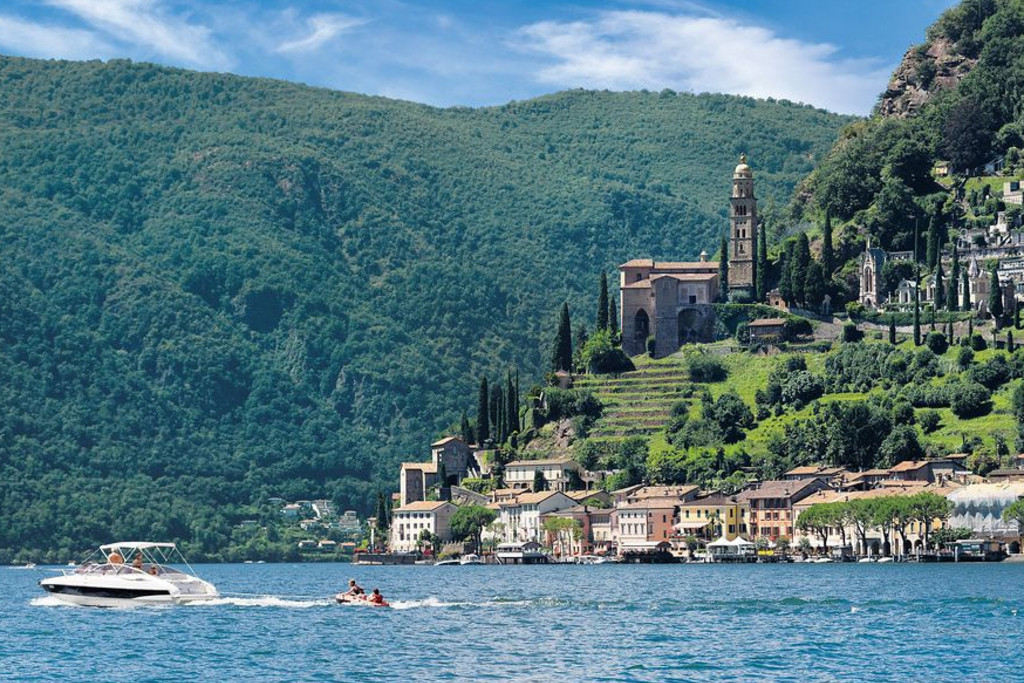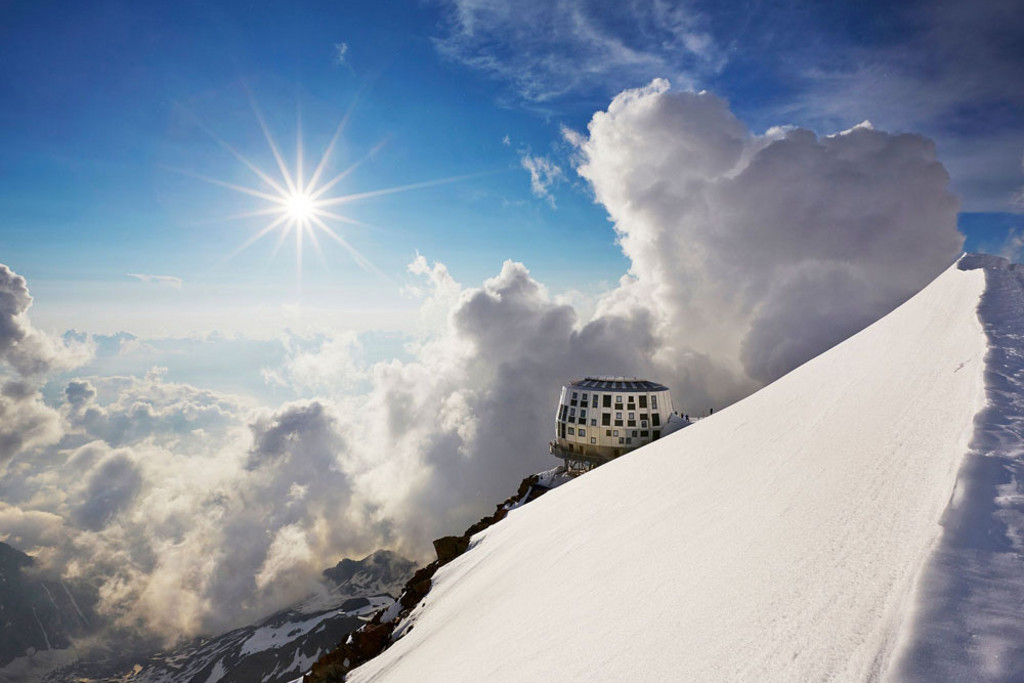
The picture-postcard village


The silhouette of Mont Blanc is very familiar to the French-speaking Swiss. The Swiss de Saussure invented mountaineering there. The new Refuge du Goûter is also the work of two Swiss architects.
In Geneva, tourists heading down Rue du Mont-Blanc towards the lake – in good weather – see the immaculate and rounded profile of a mountain rising up in front of them that towers above all others – it is of course Mont Blanc. Further on towards Lausanne on the hills overlooking Lake Geneva, the great protrusion – on which Horace-Bénédict de Saussure, a scientist from Geneva, set his heart in the 18th century – tantalises those on the ground. “There is a superb view of Mont Blanc from Bussigny where my wife lives,” remarks Jérôme Terrettaz, a mountain guide from Valais, who has climbed this peak more than 15 times, with an element of emotion and pleasure on each occasion, despite the summit’s great popularity. Standing at 4,808 metres, it attracts 20,000 climbers a year, only half of whom make it to the top.
“Once on this viewpoint, you see all the summits you have already scaled around you. It is like a history of the past. You also make plans for the future,” adds the 43-year-old mountaineer who has experienced some unexpected adventures with his clients on these slopes. On one occasion, a highly trained climber from Vaud completely lost his nerve just 200 metres from the top. On another, a customer who did not practise mountaineering, got to the peak as fresh as a daisy. It was his first 4,000-metre ascent. Stress is sometimes a factor but also altitude sickness, the cold or fatigue. “Up there, the wind and temperatures are different to those you experience on all other surrounding mountains. It’s like another layer of atmosphere,” explains Yoann Burkhalter, a mountain guide from Vaud. Between two and five people lose their lives each season on the normal route, known as the Goûter, according to the French National Ski and Mountaineering School.
Owing to its familiar and lofty position in the landscape, Mont Blanc holds an attraction or fascination for the inhabitants of the arc of Lake Geneva comparable with that of the Matterhorn’s aura. “From the shore you see how high this place is, as if it belongs to another world,” says Yoann Burkhalter. Passe Montagne, the guide company he works with, never fails to feature this climb in its itinerary. “We highlight Mont Blanc in the same way as the Matterhorn because it represents a milestone in a mountaineer’s career,” explains the young guide. Preparation for climbing this mountain is often undertaken in Switzerland. “Typical preparation is climbing to the French Albert Premier hut, before carrying on to sleep on the Swiss side in the Trient hut, doing a climb in the area, for example the Aiguille du Tour,” explains Jérôme Terrettaz. The Swiss certainly do not claim Mont Blanc as one of their own 4,000-metre peaks.
They are not like the Italians who believe the Italian-French border passes through the summit while the French contend that it belongs entirely to them. “The Swiss maps see it in the same way but the Italian ones do not,” points out Burkhalter. Map or not, Mont Blanc is part of the Swiss imagination.
In the specialist mountaineering shops in French-speaking Switzerland, it is a big part of business. “In summer people set off on this ascent every two to three days,” says Nicolas Fouchereau, manager of Passe Montagne in Geneva. The store hires out between 40 and 50 sets of equipment a year for Mont Blanc – consisting of an ice axe, helmet, crampons and boots. Some customers opt to kit themselves out from head to toe and novices are not uncommon. That is the paradox of this mountain – it is easy to access thanks to the Mont Blanc Tramway and is close to Switzerland, attracting vast numbers of people, some of whom do not have the ability to accomplish an ascent deemed technically straightforward but nevertheless not always easy to complete. “Of all those who fail, one third do not reach the summit for physical reasons, one third due to a lack of training or acclimatisation and the final third because of the weather conditions,” explains the French guide Daniel Traber, who has been involved in rescue missions in the mountains for 20 years. “It’s crazy to think that Mont Blanc can be climbed in a day (editorial note: departing from the Aiguille du Midi) thanks to cable cars, while just the ascent to the Dent Blanche hut takes six hours,” states Terrettaz. When he meets French guides on this Swiss peak, they tell them they find it “enjoyable and quiet”. Burkhalter dubs the Goûter the “Gotthard Tunnel of mountaineering”, without denying either the beauty or legendary nature of this ascent. Its importance in the sport’s history should not be overlooked either. “It was Gaston Rebuffat (editor’s note: a famous French mountaineer) who said that de Saussure had invented mountaineering by gazing at Mont Blanc from Geneva. This mountain appealed to the scientist. It inspired a fascination which has driven many other discoveries.”
Standing at 3,835 metres on the ice of Aiguille du Goûter, the new hut of the same name is the work of Swiss architect Hervé Dessimoz and his partner Thomas Büchi. Opened in 2013 in an atmosphere of bickering between the commune of Saint-Gervais and the French Alpine Club, the Refuge du Goûter was portrayed as a pinnacle of technology and ecology. However, not everyone agrees. For example, the smell of the sewage system is noticeable on the approach to the hut. “It’s badly designed,” says the Swiss guide Burkhalter. “The overuse of the Goûter, where people arrive without booking, puts strain on the system,” remarks French guide Daniel Traber. “You have to understand that you see people here who don’t know that they have to take off their crampons before going in,” said Valais-born Terrettaz. However, the criticisms frequently aimed at the Goûter, another of which is the narrowness of the entrance area, are perhaps inevitable. “The challenge presented by the Goûter’s high level of usage – from the route to the hut itself – is unique in the Alps,” acknowledges Burkhalter. Otherwise, the Goûter hut, with its attractive framework and ingenious and pleasant dorms, remains a real feat of architecture.
But how should you prepare for climbing Mont Blanc? By scaling steep slopes of around 1,500 metres and sleeping at altitude but by taking things step by step. The easy Swiss summits, such as Weissmies, Bishorn and Breithorn, are often attempted as part of training. And Mont Blanc itself? A good approach is to take three days. Day 1: ascent to the Tête-Rousse hut (3,167 metres) from the terminus of the Mont Blanc Tramway (over 800 metres ascent). Day 2: climb to Mont Blanc over 1,700 metres in total) and spend the night at Goûter. Day 3: return to the valley. This option offers two benefits – it means you do not sleep too high on the first day and cross the Goûter corridor – known as the “corridor of death” – early in the morning to minimise the risk of rock fall.
Full equipment costs around 2,000 Swiss francs. Scaling the summit with a week’s preparation with a Swiss guide is priced at 3,600 Swiss francs all in, according to Yoann Burkhalter.
Picture The Goûter hut designed by the architects Hervé Dessimoz and Thomas Büchi standing at 3,835 metres above sea level
Comments